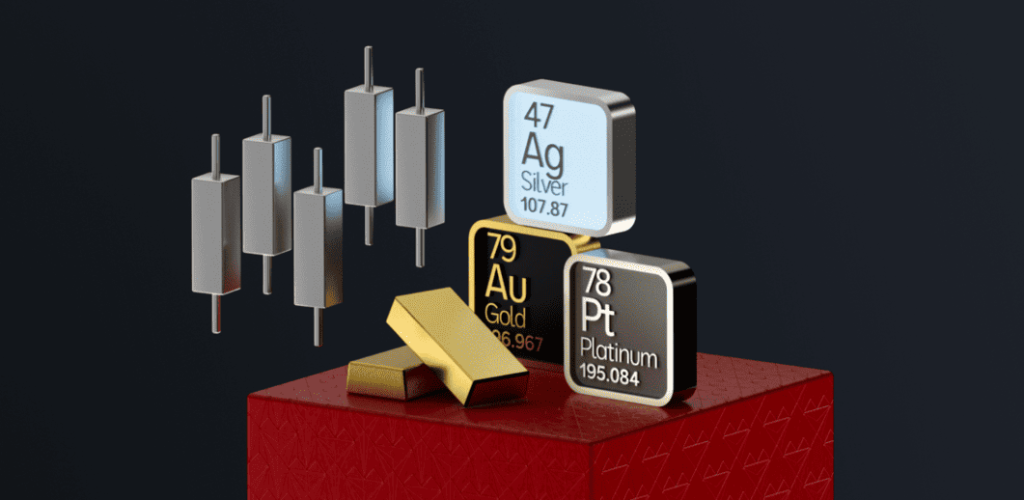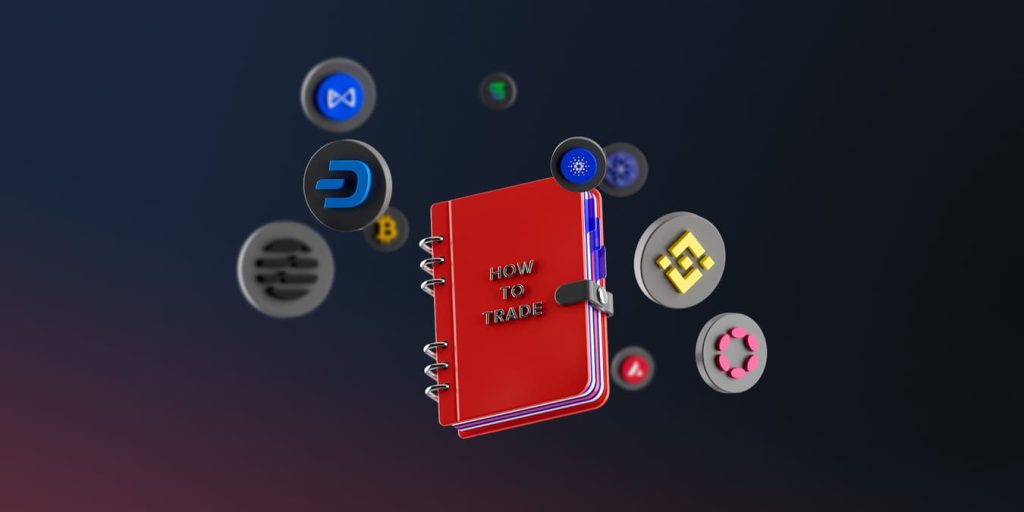
Làm thế nào để giao dịch tiền điện tử? – Hướng dẫn cho người mới bắt đầu
Mục lục
Giao dịch tiền điện tử về cơ bản là mua và bán tài sản kỹ thuật số để kiếm lời từ những biến động của thị trường. Là người mới, ý tưởng giao dịch trên thị trường thường xuyên biến động này có thể khá đáng sợ; tuy nhiên, việc nắm rõ các giai đoạn chính có thể giúp bạn bắt đầu giao dịch một cách tự tin. Hướng dẫn này cung cấp tổng quan chi tiết về quy trình giao dịch tiền điện tử cùng với các mẹo lựa chọn sàn giao dịch và chiến lược quản lý rủi ro .
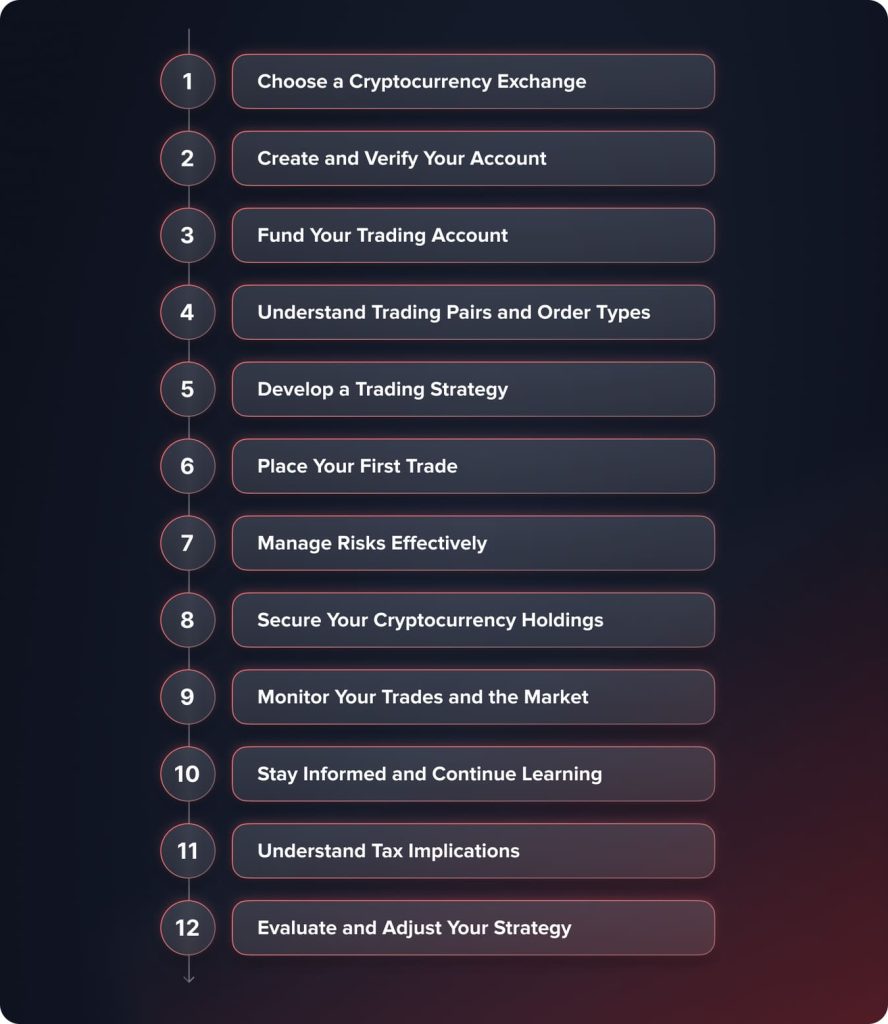
Bây giờ chúng ta hãy xem xét kỹ lưỡng từng giai đoạn.
Chọn một sàn giao dịch tiền điện tử
Bước quan trọng đầu tiên trong giao dịch tiền điện tử là lựa chọn một sàn giao dịch đáng tin cậy, phù hợp với nhu cầu của bạn. Mọi giao dịch tiền điện tử đều diễn ra tại các sàn giao dịch. Khi lựa chọn một sàn giao dịch, hãy cân nhắc các yếu tố như bảo mật, tuân thủ quy định, tiền điện tử được hỗ trợ, chính sách phí , giao diện người dùng và dịch vụ chăm sóc khách hàng đang được xem xét.

Trên hết, bảo mật là yếu tố then chốt; hãy tìm kiếm các sàn giao dịch sử dụng các cơ chế bảo mật mạnh mẽ như lưu trữ lạnh cho tiền tệ, mã hóa và xác thực hai yếu tố. Việc đảm bảo tuân thủ quy định đảm bảo giao dịch tuân thủ các hướng dẫn pháp lý tại quốc gia của bạn, từ đó mang lại thêm một mức độ bảo mật. Hơn nữa, danh mục tiền điện tử khả dụng rất đa dạng; hãy chắc chắn rằng sàn giao dịch hỗ trợ các tài sản kỹ thuật số bạn muốn giao dịch.
Các sàn giao dịch có cơ cấu phí khác nhau; do đó, để có được mức phí hợp lý, hãy so sánh chi phí nạp tiền, phí rút tiền và phí giao dịch. Đặc biệt đối với người mới bắt đầu, giao diện thân thiện với người dùng có thể giúp quá trình giao dịch trở nên đơn giản hơn. Cuối cùng, việc giải quyết mọi vấn đề phát sinh phụ thuộc vào dịch vụ khách hàng kịp thời.
Các sàn giao dịch phổ biến dành cho người mới bắt đầu bao gồm Coinbase, Binance, Kraken và Gemini, mỗi sàn đều có các công cụ và tính năng độc đáo phù hợp với sở thích đa dạng của người dùng.
Tạo và xác minh tài khoản của bạn
Việc tạo tài khoản diễn ra sau khi bạn đã chọn được sàn giao dịch. Hãy bắt đầu bằng cách thêm địa chỉ email và đặt mật khẩu mạnh, dễ nhận biết. Xác minh danh tính Khách hàng (KYC) thường được yêu cầu tại hầu hết các sàn giao dịch được cấp phép. Để chứng minh danh tính, bạn cần nộp các giấy tờ tùy thân như bằng lái xe hoặc hộ chiếu.
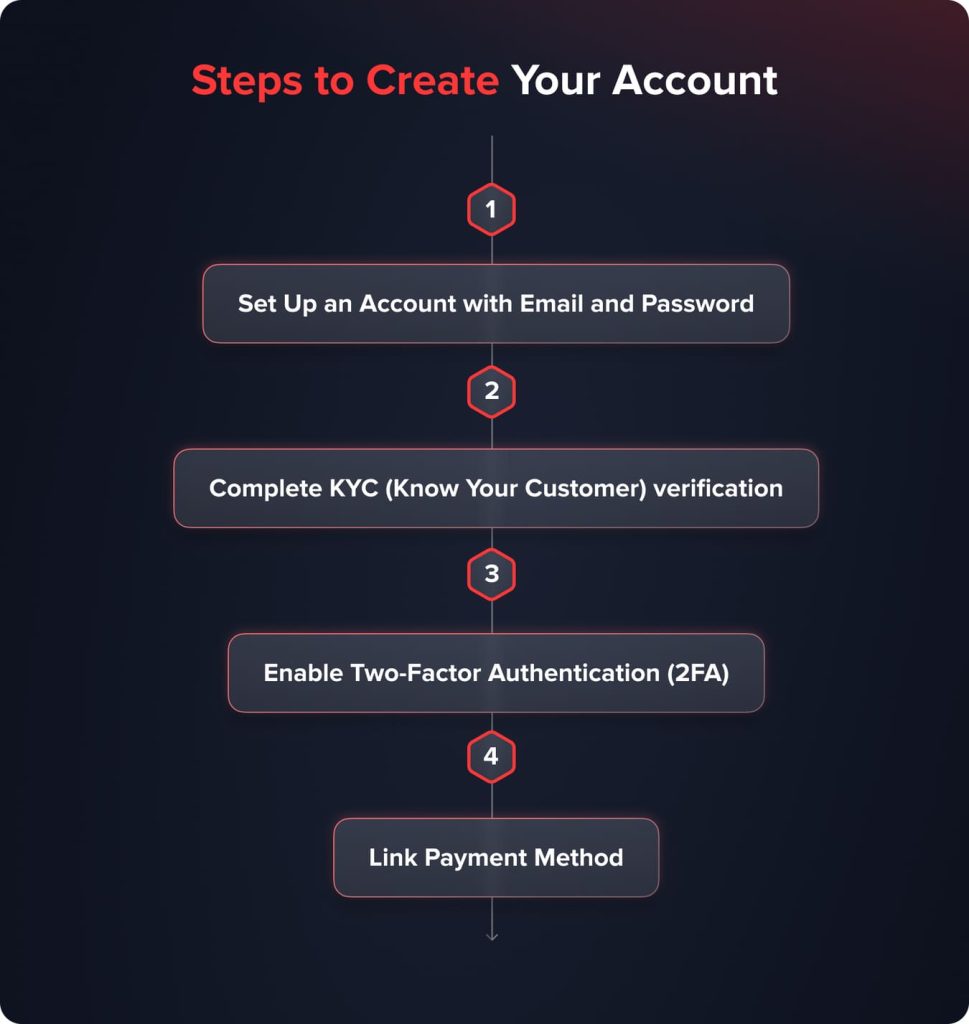
Bật xác thực hai yếu tố để bảo vệ tài khoản của bạn tốt hơn sau khi quy trình xác minh hoàn tất. Khi đăng nhập hoặc hoàn thành một số tác vụ nhất định, tính năng này thậm chí còn bảo mật hơn bằng cách yêu cầu một loại xác minh thứ hai - mã được lấy từ ứng dụng xác thực.
Liên kết tài khoản của bạn với thẻ tín dụng, tài khoản ngân hàng hoặc bất kỳ phương thức thanh toán nào mà sàn giao dịch cung cấp. Tài khoản giao dịch của bạn có thể được nạp tiền bằng phương thức đó. Bạn nên hoàn tất quy trình xác minh ngay lập tức để tránh bất kỳ sự chậm trễ nào khi sẵn sàng bắt đầu giao dịch.
Nạp tiền vào tài khoản giao dịch của bạn
Sau khi tài khoản của bạn được thiết lập và xác nhận, bước tiếp theo là nạp tiền. Bạn có thể nạp tiền vào tài khoản giao dịch bằng tiền pháp định hoặc chuyển tiền điện tử từ ví khác.
Tùy thuộc vào các tùy chọn mà sàn giao dịch cung cấp, bạn có thể sử dụng thẻ tín dụng, thẻ ghi nợ hoặc chuyển tiền từ tài khoản ngân hàng của mình để nạp tiền fiat. Vui lòng tìm hiểu các chi phí liên quan và thời gian xử lý; chúng sẽ thay đổi tùy thuộc vào loại hình thanh toán và loại tiền tệ.
Nếu bạn đã sở hữu tiền điện tử, bạn có thể gửi chúng vào ví sàn giao dịch của mình. Hãy lấy địa chỉ ví đặc biệt từ sàn giao dịch cho loại tiền cụ thể bạn muốn gửi để thực hiện việc này. Vì giao dịch tiền điện tử là vĩnh viễn và không thể đảo ngược, hãy đảm bảo bạn xác minh địa chỉ ví và các thông tin giao dịch khác trước khi chấp thuận chuyển khoản.
Hiểu về cặp giao dịch và loại lệnh
Các cặp giao dịch - tức là các cặp tài sản - được sử dụng trong giao dịch tiền điện tử. Ví dụ: BTC/USD thể hiện Bitcoin được trao đổi với tiền tệ Hoa Kỳ. Việc nắm rõ các cặp giao dịch là rất quan trọng vì nó quyết định cách bạn có thể giao dịch một loại tiền điện tử này lấy một loại tiền điện tử khác hoặc lấy tiền mặt.
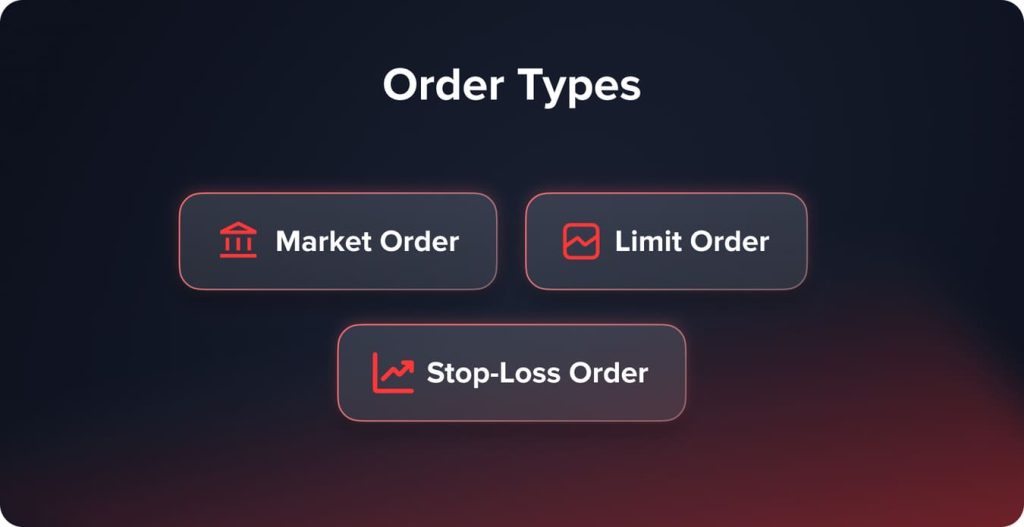
Đồng tiền đầu tiên trong cặp—ví dụ: BTC trong cặp BTC/USD—là đồng tiền cơ sở; đồng tiền thứ hai là đồng tiền định giá—USD trong cặp BTC/USD. Mua một cặp giao dịch nghĩa là bán đồng tiền định giá trong khi mua đồng tiền cơ sở.
Làm quen với nhiều loại lệnh mà sàn giao dịch cung cấp. Khi bạn muốn mua hoặc bán nhanh, lệnh thị trường sẽ được thực hiện ngay tại giá thị trường hiện tại. Lệnh giới hạn cho phép bạn quyết định mức giá mua hoặc bán; giao dịch chỉ có thể diễn ra khi thị trường đạt đến mức đó. Để giúp giảm thiểu tổn thất tiềm ẩn, lệnh dừng lỗ giúp tự động đóng vị thế ở một mức giá cụ thể.
Hiểu cách sử dụng các loại lệnh này một cách hiệu quả là rất quan trọng để thực hiện chiến lược giao dịch và quản lý rủi ro.
You may also like

Phát triển Chiến lược Giao dịch
Trong thị trường tiền điện tử, thành công phụ thuộc vào một chiến lược giao dịch được xác định rõ ràng. Trước tiên, hãy xác định mức độ chấp nhận rủi ro của bạn và đặt ra một số mục tiêu tài chính. Lựa chọn giữa giao dịch ngắn hạn - tức là giao dịch lướt sóng hoặc giao dịch trong ngày - hoặc giao dịch dài hạn bằng cách sử dụng giao dịch swing.
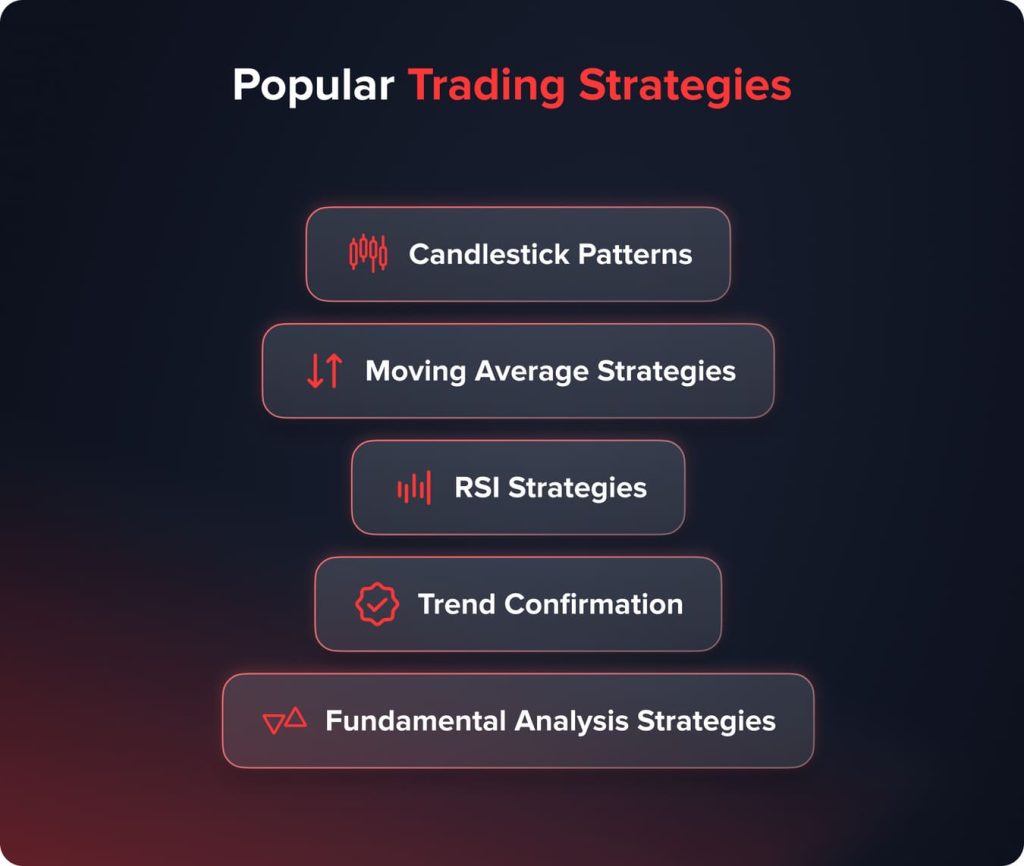
Cuối cùng, hãy kết hợp phân tích kỹ thuật vào kế hoạch của bạn bằng cách sử dụng biểu đồ và chỉ báo để dự báo những thay đổi của thị trường. Việc xác định xu hướng và các điểm vào và thoát có thể được thực hiện bằng cách sử dụng các mô hình nến, đường trung bình động và chỉ số sức mạnh tương đối (RSI). Quan trọng là, bạn phải nghiên cứu sâu hơn để xác định giá trị thực sự của một đồng tiền. Bạn có thể làm điều này bằng cách xem xét công nghệ, tỷ lệ chấp nhận, đội ngũ phát triển và bất kỳ tin tức hoặc sự kiện liên quan nào.
Việc đa dạng hóa danh mục đầu tư rất quan trọng vì nó giúp các nhà giao dịch tiếp cận nhiều nguồn thu nhập tiềm năng. Các nhà giao dịch trên nhiều loại tài sản hoặc thị trường khác nhau có thể tận dụng nhiều cơ hội khác nhau và kiếm lợi nhuận từ những biến động thị trường. Cách tiếp cận này cho phép tham gia vào sự tăng trưởng của nhiều lĩnh vực hoặc tiền điện tử, tăng khả năng danh mục đầu tư tổng thể tăng giá ngay cả khi một số tài sản hoạt động kém hiệu quả.
Liên tục tự học hỏi và sẵn sàng điều chỉnh chiến lược khi bạn có thêm kinh nghiệm và khi điều kiện thị trường thay đổi.
Đặt lệnh giao dịch đầu tiên của bạn
Chọn cặp giao dịch phù hợp với loại tiền điện tử bạn muốn mua và loại tiền tệ bạn đang sử dụng để thực hiện giao dịch đầu tiên. Xác định loại lệnh bạn muốn sử dụng theo chiến lược của mình: lệnh thị trường, lệnh giới hạn hoặc lệnh dừng lỗ.
Nhập số lượng bạn muốn mua hoặc bán, sau đó kiểm tra kỹ lưỡng tất cả thông tin giao dịch, bao gồm giá và các khoản phí. Xác nhận lệnh để thực hiện giao dịch. Bạn nên bắt đầu với số tiền nhỏ, hoặc tốt hơn nữa là sử dụng tài khoản demo, để làm quen với quy trình giao dịch và giảm thiểu rủi ro tiềm ẩn trong quá trình học hỏi.
Quản lý rủi ro hiệu quả
Việc bảo vệ tài sản và duy trì lợi nhuận lâu dài phụ thuộc vào việc kiểm soát rủi ro tốt. Đừng bao giờ đầu tư nhiều hơn mức bạn có thể chấp nhận mất; chỉ sử dụng số tiền bạn có thể chấp nhận rủi ro mà không ảnh hưởng đến các nghĩa vụ tài chính thiết yếu của mình.
Việc giảm thiểu tổn thất có thể được tự động hóa thông qua lệnh dừng lỗ. Việc thiết lập mức giá cố định để bán vị thế giúp bạn tránh được những khoản lỗ lớn nếu thị trường đảo chiều bất lợi.
Luôn cập nhật tình hình thị trường và các rủi ro tiềm ẩn. Theo dõi tin tức, diễn biến pháp lý và tâm lý thị trường, vì những yếu tố này có thể tác động đáng kể đến giá tiền điện tử.
Với tư cách là người mới bắt đầu, hãy tránh xa việc giao dịch bằng tiền vay - tức là tránh sử dụng đòn bẩy. Đòn bẩy có thể nhanh chóng gây ra nợ nần đáng kể và làm gia tăng tổn thất.
Sử dụng các chiến lược giảm thiểu rủi ro này cho phép bạn tiếp tục giao dịch và ngăn ngừa những tổn thất nghiêm trọng.
Bảo vệ khoản nắm giữ tiền điện tử của bạn
Làm việc với tiền điện tử đồng nghĩa với việc đặt bảo mật lên hàng đầu. Hãy cân nhắc việc chuyển tiền từ sàn giao dịch sang ví cá nhân, đặc biệt là để lưu trữ lâu dài. Được coi là một trong những lựa chọn an toàn nhất, ví cứng như Ledger và Trezor cung cấp khả năng lưu trữ ngoại tuyến an toàn.
Hãy bảo vệ khóa riêng tư và cụm từ khôi phục của bạn một cách cẩn thận. Lưu trữ chúng một cách an toàn và bảo mật; không bao giờ cho bất kỳ ai xem. Tránh các nỗ lực lừa đảo và giao tiếp đáng ngờ có thể lừa bạn tiết lộ thông tin cá nhân.
Việc cập nhật phần mềm và thiết bị thường xuyên giúp bảo vệ bạn khỏi các lỗ hổng bảo mật. Các bước bảo mật này giúp giảm đáng kể nguy cơ bị đánh cắp tài sản và truy cập trái phép.
You may also like

Theo dõi giao dịch và thị trường của bạn
Việc đưa ra quyết định giao dịch thông minh đòi hỏi bạn phải chủ động theo dõi các giao dịch và cập nhật tình hình thị trường. Việc thường xuyên xem xét các vị thế mở cho phép bạn đánh giá liệu chúng có đang hoạt động như mong đợi hay không và giúp bạn phản ứng nhanh chóng với những thay đổi trên thị trường. Hãy sử dụng các công cụ giám sát danh mục đầu tư cung cấp dữ liệu theo thời gian thực về tài sản của bạn để bạn có thể theo dõi lỗ hoặc lãi và điều chỉnh chiến lược giao dịch. Việc thiết lập cảnh báo giá cũng giúp bạn nhận biết những thay đổi đáng kể trên thị trường, từ đó tránh được rủi ro hoặc bỏ lỡ những cơ hội giá trị.
Ngoài các giao dịch riêng của bạn, bạn nên theo dõi toàn bộ tình hình thị trường. Luôn cập nhật tin tức ngành, những thay đổi về luật pháp và các sự kiện kinh tế thế giới có khả năng ảnh hưởng đến giá trị tiền điện tử. Tham gia các diễn đàn cộng đồng và tham khảo các nguồn tin tức đáng tin cậy có thể cung cấp những phân tích sâu sắc về tâm lý thị trường. Việc có được bức tranh toàn cảnh về thị trường giúp bạn dự đoán xu hướng, nhận ra các cơ hội mới và giảm thiểu rủi ro liên quan đến những thay đổi đột ngột trong ngành.
Luôn cập nhật thông tin và tiếp tục học tập
Thị trường tiền điện tử rất sôi động và liên tục biến động. Việc đưa ra quyết định giao dịch thông minh phụ thuộc vào việc nắm bắt thông tin. Hãy theo dõi các nguồn tin tức đáng tin cậy, phân tích thị trường và cập nhật từ kênh chính thức của các dự án tiền điện tử.
Tham gia cộng đồng thông qua các diễn đàn như Reddit, Twitter và các nhóm thảo luận chuyên biệt. Điều này có thể cung cấp những hiểu biết giá trị, góc nhìn đa chiều và cảnh báo về các biến động tiềm năng của thị trường.
Hãy dành thời gian học hỏi thông qua việc đọc tài liệu, hội thảo trực tuyến và các khóa học. Hiểu biết về công nghệ blockchain, tâm lý thị trường và các phương pháp giao dịch tinh vi có thể giúp bạn định hướng thị trường hiệu quả.
Chủ động học tập giúp bạn thích nghi với những thay đổi và nhận ra những cơ hội mới.
Hiểu các tác động về thuế
Quyền hạn pháp lý của bạn sẽ quyết định việc giao dịch tiền điện tử có phải chịu thuế hay không. Việc ghi chép đầy đủ mọi giao dịch bạn thực hiện—bao gồm ngày tháng, số tiền, giá trị giao dịch và mục đích giao dịch—là rất quan trọng.
Hãy tham khảo ý kiến của kế toán viên hoặc cố vấn thuế am hiểu các quy định về tiền điện tử tại địa phương. Về thuế thu nhập từ vốn, báo cáo thu nhập và bất kỳ khoản khấu trừ nào có liên quan, họ có thể giúp bạn hiểu rõ trách nhiệm của mình.
Việc báo cáo thu nhập đúng cách và tuân thủ luật thuế sẽ giúp bạn tránh được các vấn đề pháp lý và hình phạt tiềm ẩn. Việc cập nhật thông tin về các quy định thuế cũng cho phép bạn lập kế hoạch hoạt động giao dịch hiệu quả hơn.
Đánh giá và điều chỉnh chiến lược của bạn
Việc duy trì hiệu quả và tính phù hợp của chiến lược giao dịch phụ thuộc vào việc đánh giá thường xuyên chiến lược đó so với các mục tiêu tài chính của bạn. Sau một thời gian giao dịch tích cực, hãy xem xét lại kết quả bằng cách xem xét cả các giao dịch có lãi và lỗ. Liệt kê những thói quen hoặc xu hướng mang lại kết quả thành công cũng như những sai lầm tốn kém dẫn đến thua lỗ. Phương pháp tự vấn này giúp bạn hiểu rõ điểm mạnh và điểm yếu của chiến lược, tạo nền tảng cho những điều chỉnh sáng suốt.
Thành công lâu dài trong thị trường tiền điện tử luôn biến động phụ thuộc vào việc bạn thay đổi cách tiếp cận dựa trên những đánh giá này. Khi cần thiết, hãy sẵn sàng bổ sung các công cụ mới, thay đổi phương pháp giao dịch hoặc điều chỉnh chiến lược quản lý rủi ro. Hãy linh hoạt trước những biến động của thị trường bằng cách luôn học hỏi và sẵn sàng tiếp thu phản hồi. Theo thời gian, bằng cách trau dồi phương pháp, bạn sẽ tăng khả năng thành công bền vững và tự mình vượt qua sự phức tạp của giao dịch.
Phần kết luận
Từ việc lựa chọn một sàn giao dịch uy tín đến việc thực hiện giao dịch dựa trên một chiến lược rõ ràng, giao dịch tiền điện tử đòi hỏi một chuỗi các quyết định thận trọng. Mặc dù có tiềm năng lợi nhuận, hãy tiếp cận giao dịch tiền điện tử một cách cẩn thận, hợp lý và có tầm nhìn dài hạn. Làm theo lời khuyên trong tài liệu này sẽ giúp các nhà giao dịch mới bắt đầu xây dựng nền tảng vững chắc cho hành trình giao dịch của họ.
FAQ
Thật vậy, giao dịch tiền điện tử hàng ngày có thể mang lại 100 đô la, nhưng nó cũng đòi hỏi kiến thức, chuyên môn và vốn đáng kể. Bản chất rất thất thường của thị trường tiền điện tử mang lại cả rủi ro thua lỗ và tiềm năng lợi nhuận đáng kể. Phương pháp giao dịch của bạn, tình hình thị trường và số tiền bạn sẵn sàng đầu tư đều sẽ ảnh hưởng đến việc bạn kiếm được số tiền này một cách ổn định.
Nhờ vốn hóa thị trường lớn và tính thanh khoản cao, các loại tiền điện tử như Bitcoin (BTC) và Ethereum (ETH) thường được khuyến nghị cho người mới bắt đầu. Những loại tiền điện tử nổi tiếng này rất phù hợp cho người mới bắt đầu tìm hiểu nền tảng giao dịch vì biến động giá của chúng ổn định hơn so với các altcoin nhỏ hơn. Việc bắt đầu với các tài sản nổi tiếng cho phép người mới bắt đầu dễ dàng tham gia thị trường hơn.
Mặc dù đi kèm với biến động và rủi ro lớn, tiền điện tử có thể là một lựa chọn thú vị cho những người mới bắt đầu tìm kiếm triển vọng đầu tư mới. Trước khi giao dịch, người mới bắt đầu nên tìm hiểu kỹ về hoạt động của tiền điện tử và công nghệ blockchain. Mục tiêu tài chính, khả năng chịu đựng rủi ro và sự sẵn sàng dành thời gian nghiên cứu thị trường của bạn sẽ quyết định liệu tiền điện tử có sinh lời hay không.
Đã cập nhật:
19 tháng 12, 2024

